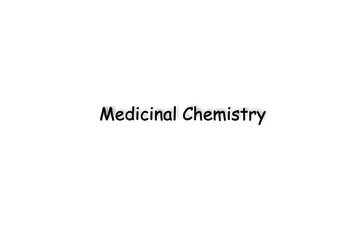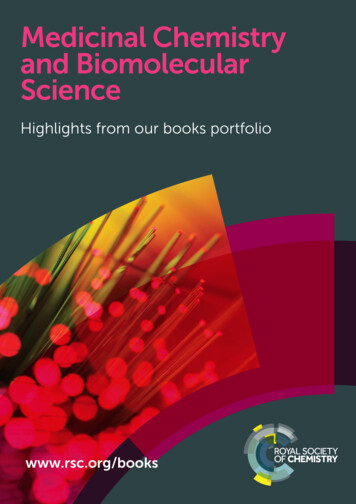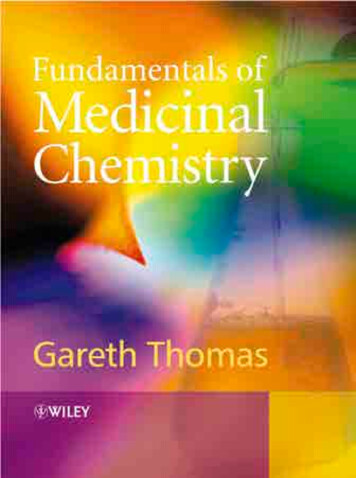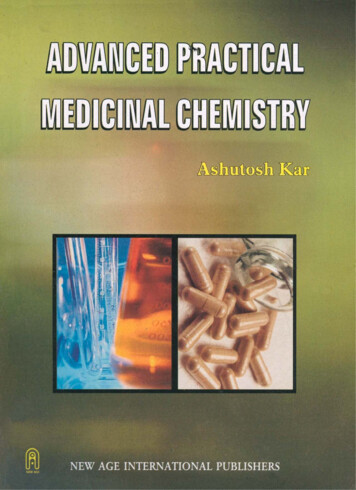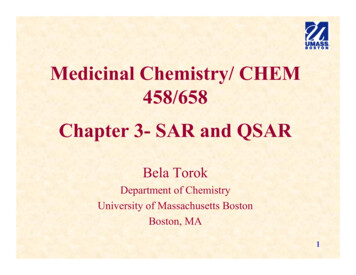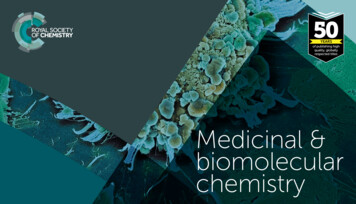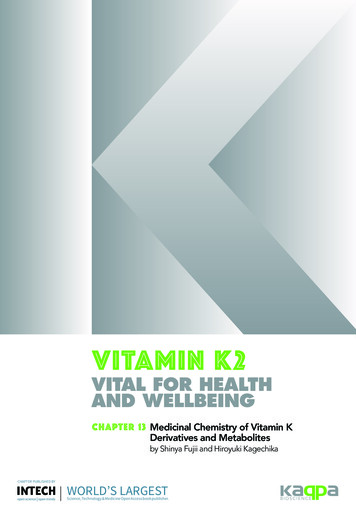
Transcription
2CHAPTER 13 Medicinal Chemistry of Vitamin KDerivatives and Metabolitesby Shinya Fujii and Hiroyuki KagechikaCHAPTER PUBLISHED BYWORLD’S LARGESTScience, Technology & Medicine Open Access book publisher.
CHAPTER PUBLISHED BYWorld’s largest Science,Technology & MedicineOpen Access book publisher2,900 OPEN ACCESS BOOKSBOOKSDELIVERED TO151 COUNTRIES100,000 INTERNATIONALAUTHORS AND EDITORSAUTHORS AMONGTOP 1%MOST CITED SCIENTISTS94 MILLIONDOWNLOADS12.2%AUTHORS AND EDITORSFROM TOP 500 UNIVERSITIESThis chapter was first published in March 2017 by InTech in the bookVitamin K2 - Vital for Health and Wellbeing, Edited by Jan O. GordeladzeRead, download and share for al-for-health-and-wellbeing
ProvisionalchapterChapter132Medicinal ChemistryChemistry ofMedicinalof VitaminVitamin KK DerivativesDerivatives andandChapter 13MetabolitesMedicinal Chemistry of Vitamin K Derivatives and MetabolitesMetabolitesby Shinya Fujii and Hiroyuki KagechikaShinya Fujii and Hiroyuki KagechikaShinya Fujii and Hiroyuki KagechikaAdditional information is available at the end of the chapterAdditional information is available at the end of the min K acts as a cofactor for γ‐glutamyl carboxylase. Recently, various biologicalactivities of vitamin K have been reported. Anti‐proliferative activities of vitamin K,especially in vitamin K3, are well known. In addition, various physiological andpharmacological functions of vitamin K2, such as transcription modulators as nuclearsteroid and xenobiotic receptor (SXR) ligands and anti‐inflammatory effects, have beenrevealed in the past decade. Characterization of vitamin K metabolites is also importantfor clinical application of vitamin K and its derivatives. In this chapter, recent progresson the medicinal chemistry of vitamin K derivatives and metabolites is discussed.Keywords: vitamin K derivative, metabolite, antitumor activity, anti‐inflammatory ac‐tivity, steroid and xenobiotic receptor/pregnane X receptor1. IntroductionVitamin K is a specific cofactor for γ‐glutamyl carboxylase (GGCX), which catalyzes formationof γ‐carboxyglutamyl (Gla) residues in vitamin K–dependent proteins (Figure 1) [1]. Variousother biological activities of vitamin K and its derivatives have also been reported. For example,vitamin K3 (menadione), a vitamin K homologue that was considered as a synthetic vitamin K,has antitumor activity [2–5], as does vitamin K2 (menaquinone) [6, 7]. Among the homologuesof vitamin K2, menaquinone‐4 (MK‐4), which contains four isoprene units, has been intensivelyinvestigated. It binds to nuclear receptor human pregnane X receptor (PXR), which is also calledsteroid and xenobiotic receptor (SXR), and regulates transcription of osteoblastic genes [8, 9]. Italso exhibits anti‐inflammatory activity by suppressing the NF‐kB pathway [10], and has aninhibitory effect on arteriosclerosis [11]. It binds 17β‐hydroxysteroid dehydrogenase 4 and 2017 The Author(s). Licensee InTech. This chapter is distributed under the terms of the Creative Commons 2017 The Author(s). Licensee InTech. This chapter is distributed under the terms of the Creative CommonsAttribution License (http://creativecommons.org/licenses/by/3.0), which permits unrestricted use, distribution,Attribution License (http://creativecommons.org/licenses/by/3.0), which permits unrestricted use,and reproduction in any medium, provided the original work is properly cited.distribution, and reproduction in any medium, provided the original work is properly cited.239
2240Vitamin K2 - Vital for Health and Wellbeingmodulates estrogen metabolism [12]. Further, it enhances testosterone production [13, 14], andshows growth‐inhibitory activity toward hepatocellular carcinoma (HCC) cells [6, 7]. Thesebiological activities of vitamin K and its analogues are attractive targets of drug discovery, andthe activities of vitamin K metabolites have also attracted much interest. A great many naturaland synthetic biologically active 1,4‐naphthoquinone derivatives (i.e., vitamin K derivatives)have been reported. In this chapter, we will focus on three medicinal‐chemistry studies of vitaminK activities.Figure 1. Structures of vitamin K homologues.2. Menadione derivatives as antitumor agentsThe antitumor activity of thioether derivatives is one of the most intensively investigated fieldsin the medicinal chemistry of menadione derivatives. Several series of naphthoquinonederivatives and benzoquinone derivatives bearing an alkyl, alkoxy, or alkylthio group as a sidechain have been synthesized and biologically evaluated by assay of growth‐inhibitory activitytoward human hepatoma cell line HepB3. Almost all of the tested compounds, as well as theparent menadione, exhibited significant inhibitory activity, and the alkylthio derivatives weremore potent than the corresponding alkyl and alkoxy derivatives. Among these compounds,a 2‐hydroxyethylthio derivative Cpd 5 (compound 5; NSC 672121) exhibited the most potentactivity (Figure 2) [15]. Subsequent studies revealed that Cpd 5 irreversibly inhibits growth‐regulatory phosphatase Cdc25 by arylating a cysteine residue in the catalytic site, causing cell‐cycle arrest [16–19].Figure 2. Compounds tested in the initial work on development of Cpd5.242
Medicinal Chemistry of Vitamin K Derivatives and Metaboliteshttp://dx.doi.org/10.5772/63511Based on the finding that Cpd5 inhibits Cdc25 and exerts antitumor activities, variousmenadione derivatives have been developed as candidate antitumor compounds. Bis(2‐hydroxyethylthio)naphthoquinone derivative NSC 95397 (Figure 3) showed potent Cdc25‐inhibitory activity and inhibited proliferation of several cancer cell lines with greater potencythan that of Cpd 5 [20]. Hydroxylated NSC 95397 derivatives exhibited enhanced Cdc25‐inhibitory activity and inhibited growth of several cancer cell lines [21]. Fluorinated Cpd 5 wasthree times more potent than Cpd‐5 itself in Hep3B growth inhibition and induced phosphor‐ylation of ERK1/2, JNK1/2 and p38 in HepB3 cells [22]. Calculations suggested that fluorinatedCpd 5 cannot generate reactive oxygen species because of its modified redox profile, andtherefore, the compound appears to function as a pure arylating agent [23]. Modification ofthe core structure afforded a maleimide derivative PM‐20 with a submicromolar IC50 value forHepB3 growth inhibition. Structure‐activity relationship study indicated that the biphenylstructure of PM‐20 is essential for activity (Figure 3) [24].Figure 3. Structures of Cpd 5 derivatives bearing a 2‐hydroxyethylthio moiety.Modification of the hydroxyethyl side chain of Cpd‐5 and NSC 95397 was also investigated.Carboxylic acid derivatives such as compounds 1, 3, and 4 (Figure 4) were designed to interactwith arginine residues in the catalytic site of Cdc25B, and indeed, they exhibited potentCdc25B3‐inhibitory activity [25, 26]. Though the cytotoxic activities of these carboxylic acidderivatives, especially dicarboxylic acid 4, were low, prodrug‐type benzyl ester derivativesexhibited enhanced growth‐inhibitory activity toward HeLa cells. It was also found that Cpd5 derivatives bearing a modified terminal, such as 6, showed selective cytotoxicity towardneuroblastoma cell lines, whereas the parent menadione and Cpd 5 exhibited cytotoxicitytoward both neuroblastoma cells and normal cell lines [27]. Aminoalkylmenadione derivativessuch as 7 showed angiogenesis‐inhibitory activity (Figure 4) [28].243241
2242Vitamin K2 - Vital for Health and WellbeingFigure 4. Examples of side chain‐modified Cpd 5 derivatives.A natural product, plumbagin (5‐hydroxymenadione, Figure 5), shows anticancer andantiproliferative activities [29]. It suppresses the NF‐kB activation pathway by modulating p65and IkBα kinase activation to potentiate cytokine‐ and drug‐induced apoptosis [30]. Structur‐ally related naphthoquinone derivatives juglone and 1,4‐naphthoquinone exerted similarTNFα‐induced NF‐kB inhibitory activities, whereas menadione did not [30]. Another naturalproduct, lapachol, which has a hydroxyl group instead of the methyl group of MK‐1, hasanticancer activity [31]. A synthetic analogue 8 bearing two isoprene units also exertedantitumor activity (Figure 5) [32], and various biologically active lapachol derivatives havebeen developed [33]. The 2‐hydroxy‐1,4‐naphthoquinone structure has distinct chemistry; forexample, it has the characteristics of 1,2‐naphthoquinone (e.g., lapachol can cyclize to form α‐lapachone or β‐lapachone), in contrast to 2‐methyl‐1,4‐naphthoquinone.Figure 5. Some vitamin K–related naphthoquinone derivatives with antitumor activity.3. Structure‐activity relationship of MK‐4 derivatives as nuclear SXRligandsIn the early twenty‐first century, it was found that MK‐4 binds a nuclear receptor, steroid, andxenobiotic receptor (SXR), which is a human homologue of pregnane X receptor (PXR), and244
Medicinal Chemistry of Vitamin K Derivatives and s transcription of osteoblastic genes [8, 9]. Structure‐activity relationships of MK‐4 asan SXR ligand were intensively investigated by Suhara et al., using deuterated derivatives(Figure 6). Saturation of double bond(s) in the side chain significantly reduced the SXRagonistic activity. Triene derivative 9 bearing a 6,7‐saturated side chain exerted only moderateactivity, and diene 10, monoene 11 (phylloquinone‐d7), and alkyl derivative 12 were inactive.Removal of methyl groups also reduced the activity, but demethylated compounds 13–16 stillretained significant activity [34].Figure 6. Compounds used in SAR study of SXR.The length of the side chain is important for the SXR activity of menaquinones. MK‐1 bearingone prenyl group showed little ligand potency, while MK‐2, MK‐3, and MK‐4 were more active.In the SXR‐GAL4 one hybrid assay system, MK‐3 was the most potent compound, and MK‐2and MK‐4 showed somewhat lower activity. In the assay system using SXRE, MK‐2, and MK‐3 were the most potent compounds [35]. “Double side chain” vitamin K analogues bearing thesame side chains at the 2‐position and 3‐position of the naphthoquinone ring were alsodesigned and synthesized. MK‐1‐W and MK‐2‐W were as potent as MK‐3 and MK‐4, whereasMK‐3‐W, MK‐4‐W, and PK‐W showed little activity (Figure 7) [35].Figure 7. Structures of double side chain vitamin K analogs.Substitution at the terminal of the side chain of menaquinones significantly affects SXR ligandpotency. Hydroxylated derivatives MK‐2‐ω‐OH, MK‐3‐ω‐OH, and MK‐4‐ω‐OH showed littleactivity in the SXR‐GAL4 one hybrid assay system, whereas compounds 17 and 18 bearing a245243
2244Vitamin K2 - Vital for Health and Wellbeingterminal phenyl group exhibited more potent activity than the parent menaquinones(Figure 8). Compounds 17 and 18 also exhibited potent activity in the SXRE assay system[36]. Thus, a suitable hydrophobic side chain is essential for SXR activity of menaquinones.Interestingly, Suhara et al. also found that menaquinone derivatives bearing a terminalhydrophobic substituent have the ability to induce selective neuronal differentiation ofneuronal progenitor cells. The most potent compound 19 was twice as effective as the EtOHcontrol, based on quantitation of Map2 mRNA (Figure 8) [37].Figure 8. Structures of menaquinone derivatives with modified terminal.4. Synthesis and biological activity of menaquinone metabolitesThe biological activities of metabolites of vitamin K are also important. MK‐4 is one of the mostinteresting vitamin K homologues because of its multifunctional properties, and ω‐carboxylhomologues of MK‐4 (MK‐4‐ω‐COOH), K acid I, K acid II and their glucuronides have beenidentified as metabolites [38–42]. It is considered that MK‐4 is initially metabolized to MK‐4‐ω‐COOH by ω‐oxidation, followed by β‐oxidation to afford intermediary carboxylic acids(Figure 9) [43]. These carboxylic acids can be categorized into two groups; MK‐n‐ω‐COOHderivatives bearing a α,β‐unsaturated carboxy group and MK‐n‐(ω‐2)‐COOH derivativesbearing a γ,δ‐unsaturated carboxy group. Chemical synthesis of these metabolites is essentialfor evaluation of their properties, and several synthetic routes have been reported.246
Medicinal Chemistry of Vitamin K Derivatives and Metaboliteshttp://dx.doi.org/10.5772/63511Figure 9. Putative catabolic pathways of MK‐4.4.1. Synthesis of menaquinone metabolitesThe MK‐4 metabolites K acid I and K acid II are also metabolites of phylloquinone (vitaminK1). Several chemical syntheses of K acid I and K acid II have been reported. Watanabe et al.synthesized K acid I by direct addition of a carboxy side chain to the naphthoquinone frame‐work using BF3 etherate [44]. A route involving a malonyl derivative and decarboxylation wasalso investigated (Figure 10) [45]. They also synthesized K acid II. Addition of a side chainmoiety by Friedel‐Crafts acylation, followed by Clemmensen reduction, afforded naphthyl‐carboxylic acid, and oxidation of the naphthol moiety using Fremy's salt gave K acid II. Directalkylation of naphthoquinone using peroxide also afforded K acid II (Figure 11) [44].247245
2246Vitamin K2 - Vital for Health and WellbeingFigure 10. Synthetic route to K acid I (Watanabe et al.).Figure 11. Synthetic route of K acid II (Watanabe et al.).Figure 12. Synthetic routes of K acid I and K acid II (Teitelbaum et al.).248
Medicinal Chemistry of Vitamin K Derivatives and um et al. synthesized K acid I and K acid II by oxidation of MK‐2 and MK‐1, respec‐tively. They prepared intermediary MK‐n using a menadione‐cyclopentadiene adduct as thesame starting material (Figure 12) [46].Okamoto et al. synthesized MK‐1‐ω‐COOH by using Wittig reaction as a key step. To preparethe intermediary aldehyde, they employed alkylation and oxidative cleavage (Figure 13) [47].Figure 13. Synthesis of MK‐1‐ω‐COOH (Okamoto et al.).Terao et al. synthesized MK‐3‐(ω‐2)‐COOH and MK‐4‐(ω‐2)‐COOH using Claisen rearrange‐ment as a key reaction. Claisen reaction of triethyl orthoacetate and MK‐n derivative gave two‐carbon‐atom‐extended carboxylic acid esters, and then hydration afforded MK‐n‐(ω‐2)‐COOHderivatives (Figure 14) [48].Figure 14. Synthesis of MK‐n‐(ω‐2)‐COOH derivatives (Terao et al.).Masaki et al. employed sulfur‐contractive anionic [2,3]‐sigmatropic rearrangement for sidechain elongation. Treatment of allyl sulfide with base afforded two‐carbon‐atom‐extendedcarboxylic acid esters in one pot (Figure 15). MK‐2‐(ω‐2)‐COOH and MK‐3‐(ω‐2)‐COOH wereobtained in this way [49].249247
2248Vitamin K2 - Vital for Health and WellbeingFigure 15. Synthesis of MK‐n‐(ω‐2)‐COOH derivatives (Masaki et al.).Fujii et al. reported systematic synthesis of menaquinone metabolites. MK‐n‐ω‐COOHderivatives were synthesized by oxidation of the terminal carbon of MK‐n derivatives.Stereoselective oxidation with selenium oxide, followed by stepwise oxidation, gave MK‐n‐ω‐COOH derivatives. K acid II was synthesized by hydrogenation of MK‐1‐ω‐COOH (Fig‐ure 16) [50]. MK‐n‐(ω‐2)‐COOH derivatives were synthesized by oxidative cleavage of MK‐nderivatives. Epoxidation of terminal olefin followed by perchloric acid treatment afforded 1,2‐diols. Oxidative cleavage of the diol moiety followed by oxidative reactions gave MK‐n‐(ω‐2)‐COOH derivatives (Figure 17) [50]. These synthetic schemes correspond to the putativecatabolic pathways of menaquinones, that is, ω‐oxidation and β‐oxidation.Figure 16. Synthesis of MK‐n‐ω‐COOH derivatives (Fujii et al.).250
Medicinal Chemistry of Vitamin K Derivatives and Metaboliteshttp://dx.doi.org/10.5772/63511Figure 17. Synthesis of MK‐n‐(ω‐2)‐COOH derivatives (Fujii et al.).Suhara et al. designed and synthesized ω‐hydroxy derivatives (ω‐alcohols) and ω‐formylderivatives (ω‐aldehydes) as menaquinone metabolite analogs. ω‐Oxidized side chain moietieswere prepared from corresponding isoprene derivatives, and the side chain parts wereintroduced into the naphthalene core. Oxidation to quinone form afforded ω‐alcohols, andthen PDC oxidation afforded ω‐aldehydes (Figure 18) [51, 52].Figure 18. Synthesis of MK‐n‐ω‐alcohols and MK‐n‐ω‐aldehydes (Suhara et al.).4.2. Biological activities of menaquinone metabolitesThese menaquinone carboxylic acid derivatives and related quinone carboxylic acids, includ‐ing ubiquinone derivatives and tocopheryl derivatives, show lysosomal membrane‐stabilizingactivity [45, 47]. Appropriate hydrophobicity of the side chain appears to be essential for thisactivity. Some of these compounds also exert inhibitory effects on the generation of the slow‐reacting substance of anaphylaxis [48].251249
2250Vitamin K2 - Vital for Health and WellbeingMK‐4 has various biological activities, such as anti‐inflammatory activity and antitumoractivity, and these activities of the menaquinone metabolites were also investigated. All testedmenaquinone metabolites inhibited LPS‐induced production of proinflammatory cytokines inRAW264.7 cells [50]. It is suggested that naphthoquinone structure is essential for the anti‐inflammatory activity of menaquinone derivatives. Regarding antitumor activity, severalcarboxylic acids, such as MK‐2‐ω‐COOH, significantly inhibited proliferation of JHH7 andHepG2 hepatocellular carcinoma cell lines. On the other hand, MK‐2‐ω‐COOH did not inhibitproliferation of normal hepatic cells. Anti‐proliferative activity may be associated withcaspase/transglutaminase‐related pathways [53].The ω‐alcohols and ω‐aldehydes showed apoptosis‐inducing activity toward human leukemiacell line HL‐60 and human osteosarcoma cell line MG‐63. The ω‐aldehydes were more potentthan the corresponding ω‐alcohols [51, 52]. The vitamin K potency of MK‐4‐ω‐OH, that is, itscoenzyme activity for GGCX, was also evaluated. MK‐4‐ω‐OH showed a larger Vmax/Km valuethan that of intact MK‐4, indicating that MK‐4‐ω‐OH has greater coenzyme activity than MK‐4 [52].5. Future perspectiveVitamin Ks are attractive lead compounds for drug discovery. One of the most promisingapplications is as candidate antitumor agents, though the mechanism of action of Cpd 5 couldbe different from that of intact vitamin Ks. In addition, bone homeostasis and neural effectsare also possible targets of vitamin K derivatives. Vitamin K may also be used as a foodsupplement, and therefore, characterization of its metabolites is important. It is noteworthythat some menaquinone metabolites have characteristic activities distinct from those of intactvitamin K2. Though a clinical study of MK‐4 as an agent to prevent recurrence of hepatocellularcarcinoma was terminated [54], the metabolites and their analogs still represent potential drugcandidates.Author detailsShinya Fujii1,2 and Hiroyuki Kagechika1**Address all correspondence to: kage.chem@tmd.ac.jp1 Institute of Biomaterials and Bioengineering, Tokyo Medical and Dental University, Kanda‐Surugadai, Chiyoda‐ku, Tokyo, Japan2 Institute of Molecular and Cellular Biosciences, the University of Tokyo, Yayoi, Bunkyo‐ku,Tokyo, Japan252
Medicinal Chemistry of Vitamin K Derivatives and es[1] Litwack G. ed. Vitamin K, vitamins and hormones, vol. 78, Elsevier Academic Press,New York, 2008.[2] Prasad K. N., Edwards‐Prasad J., Sakamoto A. Vitamin K3 (menadione) inhibits thegrowth of mammalian tumor cells in culture. Life Sci., 29, 1387–1392 (1981).[3] Ngo E. O., Sun T.‐P., Chang J.‐Y., Wang C.‐C., Chi K.‐H., Cheng A.‐L., Nutter L. M.Menadione‐induced DNA damage in a human tumor cell line. Biochem. Pharmacol., 42,1961–1968 (1991).[4] Wu F. Y.‐H., Chang N.‐T., Chen W.‐J., Juan C.‐C. Vitamin K3‐induced cell cycle arrestand apoptotic cell death are accompanied by altered expression of c‐fos and c‐myc innasopharyngeal carcinoma cells. Oncogene, 8, 2237–2244 (1993).[5] Juan C.‐C., Wu F. Y.‐H. Vitamin K3 inhibits growth of human hepatoma HepG2 cells bydecreasing activities of both p34‐Cdc2 kinase and phosphatase. Biochem. Biophys. Res.Commun., 190, 907–913 (1993).[6] Otsuka M., Kato N., Shao R. X., Hoshida Y., Ijichi H., Koike Y., Taniguchi H., MoriyamaM., Shiratori Y., Kawabe T., Omata M. Vitamin K2 inhibits the growth and invasivenessof hepatocellular carcinoma cells via protein kinase A activation. Hepatology, 40, 243–251 (2004).[7] Habu D., Shiomi S., Tamori A., Takeda T., Tanaka T., Kubo S., Nishiguchi S. Role ofvitamin K2 in the development of hepatocellular carcinoma in women with viralcirrhosis of the liver. JAMA, 292, 358–361 (2004).[8] Tabb M. M., Sun A., Zhou C., Grün F., Errandi J., Romero K., Pham H., Inoue S., MallickS., Lin M., Forman B. M., Blumberg B. Vitamin K2 regulation of bone homeostasis ismediated by the steroid and xenobiotic receptor SXR. J. Biol. Chem., 278, 43919–43927(2003).[9] Ichikawa T., Horie‐Inoue K., Ikeda K., Blumberg B., Inoue S. Steroid and Xenobioticreceptor SXR mediates vitamin K2‐activated transcription of extracellular matrix‐related genes and collagen accumulation in osteoblastic cells. J. Biol. Chem., 281, 16927–16934 (2006).[10] Ohsaki Y., Shirakawa H., Miura A., Giriwono P. E., Sato S., Ohashi A., Iribe M., Goto T.,Komai M. Vitamin K suppresses the lipopolysaccharide‐induced expression ofinflammatory cytokines in cultured macrophage‐like cells via the inhibition of theactivation of nuclear factor kB through the repression of IKKα/β phosphorylation. J.Nutr. Biochem., 21, 1120–1126 (2010).[11] Spronk H. M. H., Soute B. A. M., Schurgers L. J., Thijssen H. H. W., De Mey J. G. R.,Vermeer C. Tissue‐specific utilization of menaquinone‐4 results in the prevention ofarterial calcification in warfarin‐treated rats. J. Vasc. Res., 40, 531–537 (2003).253251
2252Vitamin K2 - Vital for Health and Wellbeing[12] Otsuka M., Kato N., Ichimura T., Abe S., Tanaka Y., Taniguchi H., Hoshida Y., MoriyamaM., Wang Y., Shao R.‐X., Narayan D., Muroyama R., Kanai F., Kawabe T., Isobe T., OmataM. Vitamin K2 binds 17β‐hydroxysteroid dehydrogenase 4 and modulates estrogenmetabolism. Life Sci. 76, 2473–2482 (2005).[13] Shirakawa H, Ohsaki Y, Minegishi Y, Takumi N, Ohinata K, Furukawa Y, Mizutani T.,Komai M. Vitamin K deficiency reduces testosterone production in the testis throughdown‐regulation of the Cyp11a a cholesterol side chain cleavage enzyme in rats. BiochimBiophys Acta, 1760, 1482–1488 (2006).[14] Ito A., Shirakawa H., Takumi N., Minegishi Y., Ohashi A., Howlader Z. H., Ohsaki Y.,Sato T., Goto T., Komai M. Menaquinone‐4 enhances testosterone production in ratsand testis‐derived tumor cells. Lipids Health Dis., 10, 158 (2011).[15] Nishikawa Y., Carr B. I., Wang M., Kar S., Finn F., Dowd P., Zheng Z. B., Kerns J.,Naganathan S. Growth inhibition of hepatoma cells induced by vitamin K and itsanalogs. J. Biol. Chem., 270, 28304–28310 (1995).[16] Ni R., Nishikawa Y., Carr B. I. Cell growth inhibition by a novel vitamin K is associatedwith induction of protein tyrosine phosphorylation. J. Biol. Chem., 273, 9906–9911 (1998).[17] Nishikawa Y., Wang Z., Kerns J., Wilcox C. S., Carr B. I. Inhibition of hepatoma cellgrowth in vitro by arylating and non‐arylating K vitamin analogs. Significance ofprotein tyrosine phosphatase inhibition. J. Biol. Chem., 274, 34803–34810 (1999).[18] Tamura K., Southwick E. C., Kerns J., Rosi K., Carr B. I., Wilcox C., Lazo J. S. Cdc25inhibition and cell cycle arrest by a synthetic thioalkyl vitamin K analogue. CancerRes., 60, 1317–1325 (2000).[19] Kar S. Lefterov I. M., Wang M., Lazo J. S., Scott C. N., Wilcox C. S., Carr B. I. Bindingand inhibition of Cdc25 phosphatase by vitamin K analogues. Biochemistry, 42, 10490–10497 (2003).[20] Lazo J. S., Nemoto K, Pestell K. E., Cooley K., Southwick E. C., Mitchell D. A., FureyW., Gussio R., Zaharevitz D. W., Joo B., Wipf P. Identification of a potent and selectivepharmacophore for Cdc25 dual specificity phosphatase inhibitors. Mol Pharmacol., 61,720–728 (2002).[21] Peyregne V. P., Kar S., Ham S. W., Wang M., Wang Z., Carr B. I. Novel hydroxylnaphthoquinones with potent Cdc25 antagonizing and growth inhibitory properties.Mol Cancer Ther., 4, 595–602 (2005).[22] Kar S., Wang M., Ham S. W., Carr B. I. Fluorinated Cpd 5, a pure arylating K‐vitaminderivative, inhibits human hepatoma cell growth by inhibiting Cdc25 and activatingMAPK. Biochem. Pharmacol., 72, 1217–1227 (2006).[23] Ham S. W., Choe J.‐I., Wang M.‐F., Peyregne V., Carr B. I. Fluorinated quinoid inhibitor:possible “pure” arylator predicted by the simple theoretical calculation. Bioorg. Med.Chem. Lett., 14, 4103–4105 (2004).254
Medicinal Chemistry of Vitamin K Derivatives and Metaboliteshttp://dx.doi.org/10.5772/63511[24] Kar S., Wang M., Yao W., Michejda C. J., Carr B. I. PM‐20, a novel inhibitor of Cdc25A,induces extracellular signal‐regulated kinase 1/2 phosphorylation and inhibits hepa‐tocellular carcinoma growth in vitro and in vivo. Mol. Cancer Ther., 5, 1511–1519 (2006).[25] Brun M.‐P., Braud E., Angotti D., Mondésert O., Quaranta M., Montes M., Miteva M.,Gresh N., Ducommun B., Garbay C. Design, synthesis, and biological evaluation ofnovel naphthoquinone derivatives with CDC25 phosphatase inhibitory activity. Bioorg.Med. Chem., 13, 4871–4879 (2005).[26] Braud E., Goddard M.‐L., Kolb S., Brun M.‐P., Mondésert O., Quaranta M., Gresh N.,Ducommun B., Garbay C. Novel naphthoquinone and quinolinedione inhibitors ofCDC25 phosphatase activity with antiproliferative properties. Bioorg. Med. Chem., 16,9040–9049 (2008).[27] Kitano T., Yoda H., Tabata K., Miura M., Toriyama M., Motohashi S., Suzuki T. VitaminK3 analogs induce selective tumor cytotoxicity in neuroblastoma. Biol. Pharm. Bull., 35,617–623 (2012).[28] Kayashima T., Mori M., Mizutani R., Nishio K., Kuramochi K., Tsubaki K., Yoshida H.,Mizushina Y., Matsubara K. Synthesis and biological evaluation of vitamin K deriva‐tives as angiogenesis inhibitor. Bioorg. Med. Chem., 18, 6305–6309 (2010).[29] Krishnaswamy M., Purushothaman K. K. Plumbagin: a study of its anticancer, anti‐bacterial and antifungal properties. Indian J. Exp. Biol., 18, 876–877 (1980).[30] Sandur S. K., Ichikawa H., Sethi G., Ahn K. S., Aggarwal B. B. Plumbagin (5‐hydroxy‐2‐methyl‐1,4‐naphthoquinone) suppresses NF‐kB activation and NF‐kB‐regulatedgene products through modulation of p65 and IkBα kinase activation, leading topotentiation of apoptosis induced by cytokine and chemotherapeutic agents. J. Biol.Chem., 281, 17023–17033 (2006).[31] Rao K. V., McBride T. J., Oleson J. J. Recognition and evaluation of lapachol as anantitumor agent. Cancer Res., 28, 1952–1954 (1968).[32] Hartwell J. L., Abbott B. J. Antineoplastic principles in plants: recent developments inthe field. Adv. Pharmacol. Chemother., 7, 117–209 (1969).[33] For recent examples: (i) Fiorito S., Epifano F., Bruyere C., Mathieu V., Kiss R. GenoveseS. Growth inhibitory activity for cancer cell lines of lapachol and its natural and semi‐synthetic derivatives. Bioorg. Med. Chem. Lett., 24, 454–457 (2014). (ii) Wang S.‐H., Lo C.‐Y., Gwo Z.‐H., Lin H.‐J., Chen L.‐G., Kuo C.‐D., Wu J.‐Y. Synthesis and biologicalevaluation of lipophilic 1, 4‐naphthoquinone derivatives against human cancer celllines. Molecules, 20, 11994–12015 (2015).[34] Suhara Y., Hanada N., Okitsu T., Sakai M., Watanabe M., Nakagawa K., Wada A.,Takeda K., Takahashi K., Tokiwa H., Okano T. Structure‐activity relationship of novelmenaquinone‐4 analogues: modification of the side chain affects their biologicalactivities. J. Med. Chem. 55, 1553–1558 (2012).255253
2254Vitamin K2 - Vital for Health and Wellbeing[35] Suhara Y., Watanabe M., Motoyoshi S., Nakagawa K., Wada A., Takeda K., TakahashiK., Tokiwa H., Okano T. Synthesis of new vitamin K analogues as steroid and xenobioticreceptor (SXR) agonists: insights into the biological role of the side chain part of vitaminK. J. Med. Chem. 54, 4918–4922 (2011).[36] Suhara Y., Watanabe M., Nakagawa K., Wada A., Ito Y., Takeda K., Takahashi K., OkanoT. Synthesis of novel vitamin K2 analogues with modification at the ω‐terminal positionand their biological evaluation as potent steroid and xenobiotic receptor (SXR) agonists.J. Med. Chem. 54, 4269–4273 (2011).[37] Suhara Y., Hirota Y., Hanada N., Nishina S., Eguchi S., Sakane R., Nakagawa K., WadaA., Takahashi K., Tokiwa H., Okano T. Synthetic small molecules derived from naturalvitamin K homologues that induce selective neuronal differentiation of neuronalprogenitor cells. J. Med. Chem. 58, 7088–7092 (2015).[38] Wiss O., Gloor U. Absorption, distribution, storage, and metabolites of vitamins K andrelated quinones. Vitam. Horm., 24, 575–586 (1966).[39] Watanabe M., Toyoda M., Imada I., Morimoto H. Ubiquinone and related compounds.XXVI. The urinary metabolites of phylloquinone and α‐tocopherol. Chem. Pharm.Bull., 22, 176–182 (1974).[40] McBurney A., Shearer M. J., Barkhan P. Preparative isolation and characterization ofthe urinary aglycones of vitamin K1 (phylloquinone) in man. Biochem. Med., 24, 250–267(1980).[41] Tadano K., Yuzuriha T., Sato T., Fujita T., Shimada K., Hashimoto K., Satoh T. Identifi‐cation of menaquinone‐4 metabolites in the rat. J. Pharmacobiodyn., 12, 640–645 (1989).[42] Harrington D. J., Soper R., Edwards C., Savidge G. F., Hodges S. J., Shearer M. J.Determination of the urinary aglycone metabolites of vitamin K by HPLC with redox‐mode electrochemical detection. J. Lipid. Res., 46, 1053–1060 (2005).[43] Edson K. Z., Prasad B., Unadkat J. D., Suhara Y., Okano T., Guengerich F. P., Rettie A.E. Cytochrome P450‐dependent catabolism of vitamin K: ω‐hydroxylation catalyzedby human CYP4F2 and CYP4F11. Biochemistry, 52, 8276–8285 (2013).[44] Watanabe M., Kawada M., Nishikawa M., Imada I., Morimoto H. Ubiquinone andrelated compounds. XXVII. Synthesis of urinary metabolites of phylloquinone and α‐tocopherol. Chem. Pharm. Bull., 22, 566–575 (1974).[45] Watanabe M., Okamoto K., Imada I., Morimoto H. Ubiquinone and related compounds.XXXI. Synthesis of urinary metabolites of ubiquin
medicinal chemistry of vitamin k derivatives and metabolites vitamin k2 - vital for health and wellbeing edited by jan oxholm gordeladze . open access books books delivered to 151 countries 12.2% authors and editors from top 500 univers

